 Palo Alto Stanford Heritage
Palo Alto Stanford Heritage
College Terrace was the site of the December 11, 2011 Holiday House Tour.
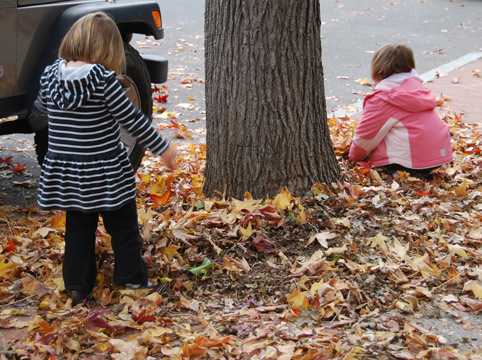
Homes and library on tour:
History of College Terrace
College Terrace is a neighborhood which contalns a wide variety of architectural styles and features—from aristocratic to humble. The atmosphere of the Terrace is that of a small community in which student and professor, great-grandmother and child, working class and professional, live next to each other and feel closely identified with their environment and with each other.
The history of College Terrace begins in 1887 when Alexander Gordon, a wealthy farmer and landowner in San Mateo County, bought 120 acres of farmland from residents Peter Spacher and Frederick Weisshaar. Senator Leland Stanford had earlier offered to buy this tongue of land which projected into his holdings but had been rejected. Gordon subdivided his land hoping to attract faculty and fraternity buyers.
The subdivision was originally named Palo Alto but later changed to College Terrace at Senator Stanford's request. Gordon chose to name the streets, in alphabetical order, after well–known colleges and universities. This sequence is interrupted by Cornell Street which was originally called Washington Street The neighboring town of Mayfìeld annexed College Terrace in 1891. Both towns became part of Palo Alto in 1925.
Each of the eight buildings on this tour, from Queen Anne to log cabin, represents College Terrace at its individualistic best. The homeowners on this tour have graciously agreed to share their houses and their respect for history with you. While you're visiting the "Handsome Residences" and "Neat Cottages" of College Terrace, take some time to admire the notable century oaks on these properties.
Link to map showing Bowdoin Street
The Bowdoin Street Cottages
In 1931, Lars Peterson built five cottages on Bowdoin Street as a speculative venture on lots which were each approximately 28' by 125'. By 1975, the then owners of these three Tudor and two Mission Revival style houses formed the Bowdoin Place Homeowner's Association. The Association agreement mandated that members would each own their houses and the small, rear patios separately. Although their privately held properties were reduced to 28' by 75', they would hold the large 160' by 50' area behind their houses in common.
The "Commons" as a property concept, goes back for centuries and has both detractors and proponents. In modern times, it is used when land is scarce to increase the sense of community and space.
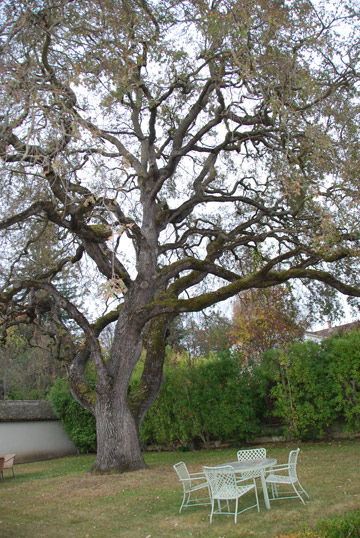
The owners of our three tour houses seem uniformly thrilled with their snug, "neat cottages" and with the park–like commons area which is sheltered by a towering oak tree. The cottages range from 625 to 925 square feet and have similar floor plans. Yet, each bears the unmistakable imprint of its owners' individuality and taste.
2216 Amherst Street—1934
Situated uphill from a magnificent 250–300 year old oak tree, this secluded "log cabin" built with clear redwood siding, charms the visitor. Once part of the adjoining property, it was built for $2,000 by the Jenkins family as a place for their young daughter to practice and teach piano while they enjoyed serene hours in their house next door at 2300 Amherst Street.
Most of the features are original to the 1934 cottage: the exterior siding, the white oak and pine floors, the windows, fireplace and the rustic redwood paneling and ceiling.
The current owners, an interior/landscape designer and a contractor, have made ingenious use of the cottage's 684 square feet. From the sleeper couch in the parlor to the glass shelving in the large rear window to the multipurpose island which is used for kitchen storage, as a bar, and as a pull–out design table, one is in awe at the minimalist ethos of the owners.
Despite the small size of this cozy house, nestled on its 38.5' x 120' lot, there is a feeling of serenity and openness. And, because of its size, the house blends and seems one with the inviting front yard.
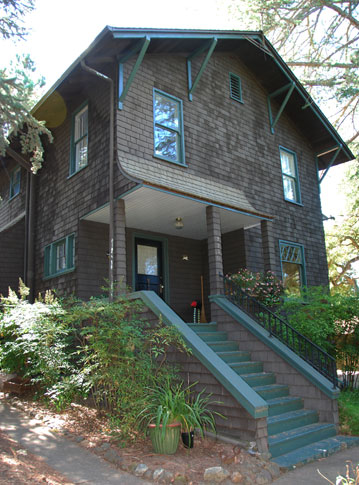 |
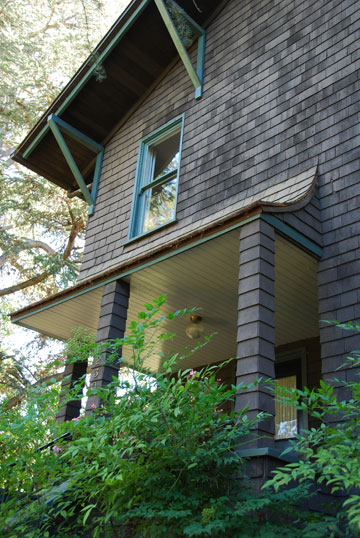 |
College Terrace has always attracted Stanford professors and students as an intimate and bohemian place to live. Standing on one of the highest points of the Terrace, this Shingle style house with its Craftsman details was built by a Stanford engineering student, James McLain Goodell. A 1909 graduate, Goodell is said to have built this two–story house during the summer after his freshman year.
The asymmetric entrance and simple braces at the eave overhang are exterior Craftsman touches. A front hall leads to a parlor on the right with an attractively paned Craftsman style window. The original oak floors and windows are intact throughout the house. An exception is in the living room to the right. Originally, this area was a sun porch with a corresponding sun porch on the second–story. In 1974, the first floor sun porch was repaired and converted to a living room with a fireplace while the upstairs porch became a library/den.
The original 1904 fireplace is on the left wall of what is now the dining area. The kitchen, remodeled by previous owners, leads on the left to a triple staircase going to the kitchen, entry, and to the second floor. At the right of the kitchen, a small redwood laundry room with original cabinetry opens to the sunny patio garden.
In 1928, the third owner of 2300 Amherst was Dr. Olaf Pitt Jenkins, a geologist, who was the chief of the State Division of Mines. His father, Oliver Peebles Jenkins came to Stanford in 1891 at the invitation of Senator Leland Stanford and was head of Stanford's Physiology Department for 25 years. Olaf Jenkins landscaped the entire property, putting in terraced lawns and preserving the trees which had been planted in 1904 by James McLeod Goodell. The latter include the Monterey pine in the rear, the beautiful Sequoia Sempervirens which dominates the front of the lot and the Deodara and Atlas Cedars. Jenkins also built the "log cabin" next door at 2216 Amherst Street.
The current owners, a retired Palo Alto High School principal and his wife, the founder of Paper Chase in Menlo Park, have enhanced the interior of the house with their collection of Mexican folk art. Residents for 56 years, they enjoy the simplicity of this Shingle style house, whose design marks an architectural turning point from Victorian flamboyance.
This home was also on the 1997 Holiday House Tour.
2275 Amherst Street—1893
An exuberant and important example of the Queen Anne Victorian style, this house was first owned by Walter Miller, a professor of Latin and an original member of Stanford's faculty. A later owner was Michael Carney, mayor of Mayfield, known as "an ardent advocate of good roads and improvements."
The house, situated on one half acre, offers a multitude of exterior embellishments: the spindles at the peak of the side gable, the scalloped shingles, the belt course between the first and second stories and the brackets over the bay windows with fan–like carving and pendant at the corner. The corner tower has a pyramid roof. The front offers a fantasy of gables: the main one with its window eyes, spindles and shingles; a false one with medallions; and, finally, one over the porch with concave medallions and an acorn pendant. A profusion of spindles, brackets and columns, sometimes called "gingerbread", are more appropriately termed "millman's folly" as they express a carpenter's irrepressible delight in using the motor–driven lathe.
The present owners have kept the original floor plan and have refurbished and, where necessary, restored both the exterior and interior. Inside, original windows, moldings, sliding pocket doors and the staircase co–exist with Pirelli flooring, an award winning master bathroom remodel and vibrant colors.
The garden was designed and built by the owners. Opposite the front entrance is an old oak tree which straddles the property line between 2275 and 2203 Amherst Street.
This architecturally significant house was originally situated on a corner lot facing what is now California Avenue. It is possible that the house was originally built as a "come–on" or model home by the developer who hoped to fill his College Terrace sub–division with "handsome residences" for faculty members. 2275 Amherst Street is listed on Palo Alto's Historic Inventory.
This house was also part of the 1997 Holiday House Tour.
2303 Amherst Street—1931
From the street, this charming yellow cottage, with its white picket fence, looks no bigger that it did in 1931 when John V. Simmons built it. The original 900 square foot house has been expanded twice since the current owner bought it in 1974. Although tripled in size, the original character of the house has been maintained. The front rooms, while repurposed and slightly enlarged, have the original oak floors and windows. The fir floors in the kitchen are also original.
The current owner, formerly a graphics designer, tackled the first major remodel in 1987. Expanding an older home on a sloping 46' x 125' lot was challenging for Berkeley architects, Burks Toma, but the results were so noteworthy that they were featured in Home Magazine. Rooms were reconfigured and a sun–filled shower room and master bedroom were added. The marble fireplace mantel in the master bedroom is from the owner's childhood home in Nevada City.
A final remodel in 2010 provided interior access to the finished basement; access had formerly been through a cellar door in the garden. The owner is an artist and plays chamber music. The current configuration combines convenience, artistry and space for her avocations. Note the steel railings on the staircase. These were created by "warping" or reheating standard metal bars to create a work of art. They were designed by the owner.
Exiting through the garden you will see a breezeway which connects the original house to the two additions and solves the issue of elevation in a unique way. The combination of old and new in 2303 Amherst is a fine example of the possibilities inherent in valuing the charm of an older house and respecting the architecture of the neighborhood.
2102 Bowdoin Street—1931
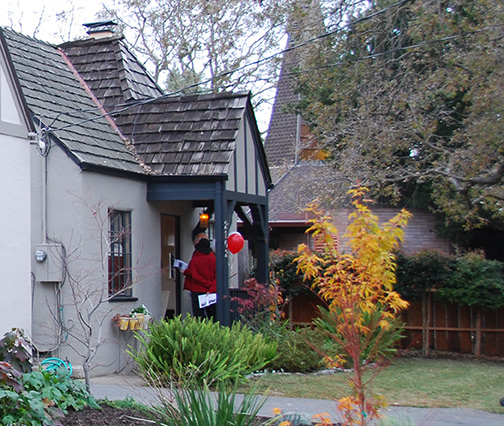
This 825 square foot house is an example of the Tudor Revival style popular throughout the United States in the 1920's and mid–1930's. A relatively small percentage of Tudors have stucco walls; these are most common on modest houses built before the widespread adoption of brick and stone veneering techniques and false half–timbering.
The quaint exterior belies the contemporary taste of the owner evident in the interior. Here, modern furniture and a renovated kitchen mingle happily with the original features of the house.
The windows, plaster walls, oak floors, bathroom tile and tub are all original to the house as are the arches. The arch motif is repeated throughout the house. We see it first in the shape of the fireplace surround with its central tile depicting a sailing ship on the high seas. (The tile used in this surround is discussed fully in the description of 2110 Bowdoin Street.) The same Tudor Gothic arch style is repeated at the entrance to the dining room and, finally, in the master bedroom. Here it provides a delicate approach to the original dressing table.
The current owner's kitchen update was deliberately subtle so as not to overwhelm the clean lines of the house. Custom-made cabinets, stainless steel appliances and limestone countertops in "Lagos Azul" were used. The backsplash is hand–made tile from Waterworks.
A work area leads to the rear patio, a restful spot for reading or conversation with friends. From this very private and tranquil area, it is a stone's throw to the park–like space of the "Commons" with its magnificent oak.
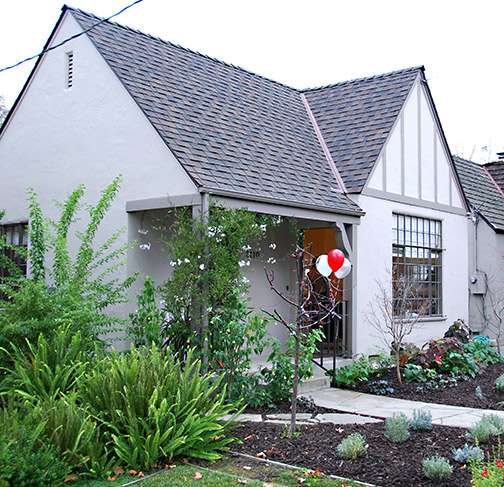
A meandering stone walkway through the low water–use front garden welcomes you to 2110 Bowdoin Street. This Tudor cottage differs from its 2102 neighbor in layout, in the angle of the front entrance, in its larger 925 square footage and in the fact that it has two bedrooms.
The oak floors, steel casement windows, plaster walls and bathroom tile all date to 1931. Notice the beautifully coved ceiling in the Living Room and the inset, arched bookcase on the rear wall. The size of this house is modest but shows the careful hand of the builder.
This care is particularly evident in the stepped surround of the fìreplace with its center large tile depicting wind swept trees. The handcrafted, artful quality of these tiles earned them the place of honor in the house—the flreplace. The center, shallow carved relief tiles were treated as individual paintings and surrounded by color coordinated fìeld tiles of a single color.
The tiles in this surround as well as the one at 2102 Bowdoin were manufactured by San Jose Tile, founded in 1926 in Milpitas. In 1931, the company name was changed to Handcraft Tile. Simplicity was the hallmark of a Handcraft tile—simple design, simple slip glazes in earthy colors of brown, tan and sometimes green. Handcraft tiles are often seen in Palo Alto houses, as there was a strong emphasis on buying locally. Considered a non-essential industry during World War II, the tile works were temporarily closed. During the early 20th century, over 150 companies manufactured artisan tiles nationally. Only four survive today and only one is in California—Handcraft Tile.
Appreciative of the charm of the house's original features, the owner has remodeled only the kitchen, which encompasses the dining area. Granite countertops, a subway tile backsplash, new appliances and an oak floor to match the existing have made this area a cheerful center of activity. The kitchen opens to the patio, which is overhung by the branches of the 250 year old oak in the "Commons."
Mission Revival Cottage
2130 Bowdoin Street—1931
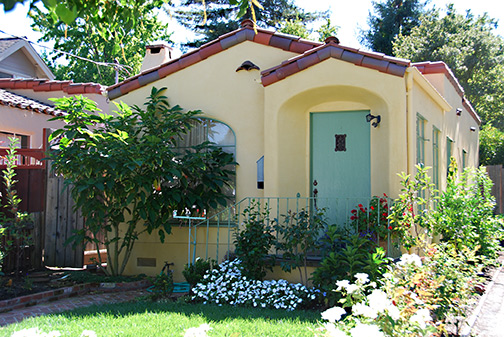
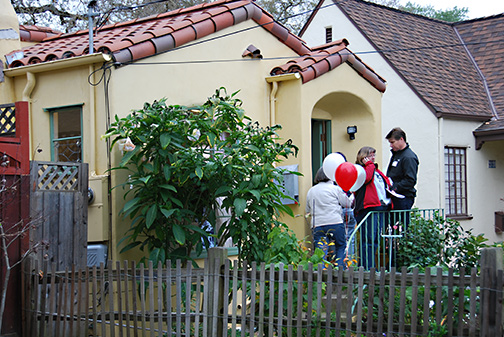
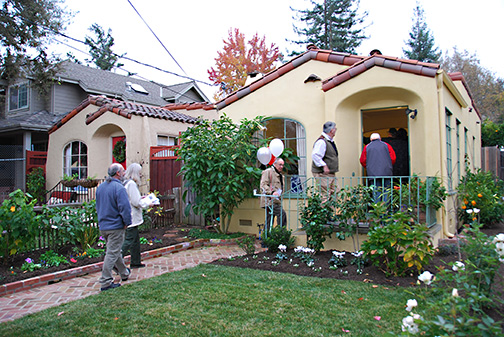
The current owner bought this Mission Revival house in 2009 and immediately embarked on a four month long remodel. Her father, who was the architect, describes the resulting style as European Mediterranean with Solar Green. Regardless of the nomenclature, the effect is an impressive use of 625 square feet.
The exterior stucco was stripped and replaced with pigmented plaster, which requires no repainting. The roof was dismantled, re–papered and the original Spanish tile replaced.
On the inside, the floor plan was rearranged to accommodate the owner's passion for books, cooking and serenity. The oak floors and windows are original except for the master bedroom window. Arched doorways and plaster over sheetrock were used to emulate the house style. Insulation, which was generally not used in the 1930's, was installed throughout.
The cabinetry in the house is IKEA as are the kitchen countertops. The kitchen floor is clipped, natural linoleum, which is made of linseed and cork.
Bathroom fìxtures are new, but the original black and white tile, which is identical to 2102 and 2110 Bowdoin, was preserved.
In remodeling this charming cottage, the owner was cognizant not only of her needs and taste but also of the character of the neighboring houses. The result is a terrific update to an older home.
The College Terrace Library is a California Colonial style building. It was designed by San Francisco based architect, Charles Sumner (1874-1948.)
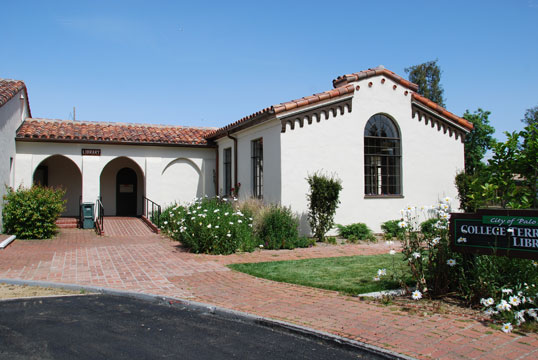
The entrance loggia features decorative relief patterns. The red tile roof and white stucco Spanish motif is reinforced inside with plaster ceilings exposed between wood beams. The steel casement and Palladian windows are original. The 1904 wall clock opposite the librarian's desk, is from Palo Alto's first public library.
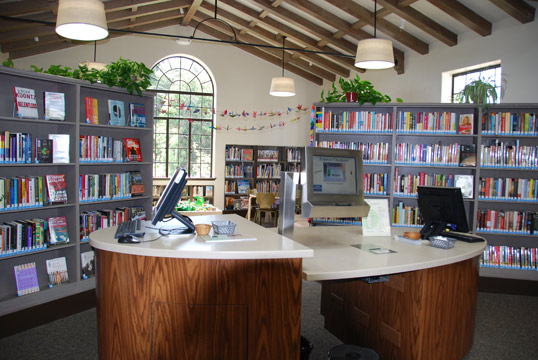
Originally built at a cost of $20,000 by WPA workmen, the library was restored and seismically retrofitted in 2010 under the supervision of Palo Alto Stanford Heritage, whose role was to ensure its architectural integrity. The restoration cost over two million dollars and was completed in November 2009.
In a city which treasures its libraries, College Terrace continues to play an important role both culturally and historically.
| |
E-mail us at either webmaster@pastheritage.org or president@pastheritage.org.
![]() Palo Alto Stanford Heritage—Dedicated to the preservation of Palo Alto's historic buildings.
Palo Alto Stanford Heritage—Dedicated to the preservation of Palo Alto's historic buildings.
Copyright © 2015 Palo Alto Stanford Heritage. All rights reserved.